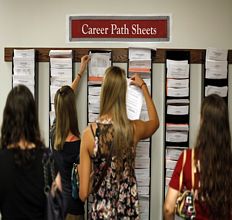GOOGLE ADSENSE
Perkins Loan Program
A high percentage of Americans utilize financial aid to pay for their education. The key is maximizing your educational success, while limiting the possibilty of experiencing a Student Loan Debt meltdown, is to know your options prior to committing to any source or sources. If you require financial aid to complete your educational dreams, you may want to take a look at the Perkins Loan Program to reach your goals. It’s a fact; only a certain percentage of students can afford to pay college without some type of educational financing. You know the kind; they come from wealthy families and they can afford… not only to pay for college out of pocket, but also enjoy not having to hold down a job while attending school. Who wouldn’t you love to be in their shoes? If you’re not, take a deeper look into the Perkins Loan Program. Since grants, scholarships, work-study and other forms of gift aid, do not usually cover the full costs of a college education for the majority of students; most resort to financial aid. Or, as it is normally classified, a student loan. As you may already know, a student loan is a type of financial aid that must be repaid, with interest. On the other hand, scholarships don’t have to be repaid. Student loans come in four categories:
In this section we are going to focus our attention on the Perkins Loan Program, which is a federal student loan program geared towards students who have the greatest financial needs. Perkins Loan Program Description Do All Perkins Loans Have To Be Repaid? In general, schools are reimbursed for one hunded percent of the principal amount of the loan canceled, and the reimbursement must be reinvested in the school's revolving loan fund. These institutional reimbursements for loan cancellations are an entitlement. Loan volume in the program comes from:
How Is a Student’s Financial Eligibility Determined? The information from the FAFSA then determines the student's expected family contribution (EFC). The fundamental elements in this standard formula are the student's income (and assets, if the student is independent), the parents' income and assets (if the student is dependent), the family's household size, and the number of family members (excluding parents) attending postsecondary institutions. Get Your Student Loan Calculator Out!
Different assessment rates and allowances are used for dependent students, independent students without dependents, and independent students with dependents. After filing a FAFSA, the student receives a Student Aid Report (SAR) or the institution receives an Institutional Student Information Record (ISIR), which provides the student's EFC. Brad Matheson is a professional Financial Consultant who specializes in helping businesses and individuals resolve their debt issues. He believes that all debt problems can be solved with the right debt advice and aspires to help Americans learn all of their debt options and exercise all of their rights. Says, Matheson, “Don't allow the Student Loan Debt crisis or a Defaulted Student Loan to hinder or block your career aspirations or stymie your financial dreams, There is Student Loan Help available!” Source: http://studentloanwhiz.com/
| |
|
Student Loan and Financial Aid Educational
Resources:
Financial Aid
| Money for College
| Federal
Student
Loan | College Scholarship Search
Minority Scholarship | College Grants
| College Search | Perkins Loans | Stafford
Loans
Parent PLUS
Loans | GradPLUS
Loans | College
Scholarships | Private
Student Loan
Student Consolidation Loans | Financial Aid Acronyms | Financial Aid Glossary
StudentLoanWhiz.com is a leading information portal dedicated to helping students and their families find the financial resources they need to complete their education goals. StudentLoanWhiz.com is your trusted resource for student loans for schools in the United States. Whatever your needs, we’re here to simplify the process by providing an unbiased evaluation of virtually every type of student loan available. You provide the will and we'll help make the way.
About Us | Contact Us | Privacy Policy | Terms of Use | Disclaimer
Home | U.S. Department of Education | College News | Site Map
Copyright © Student Loan Whiz, 2007-2012 All Rights Reserved.
Powered by the Student Loan
Whiz











